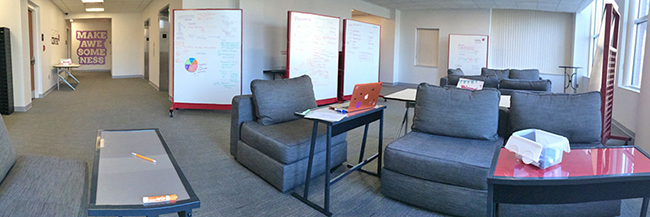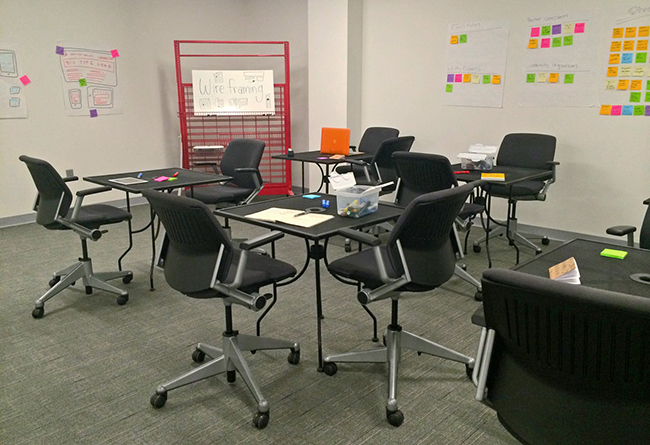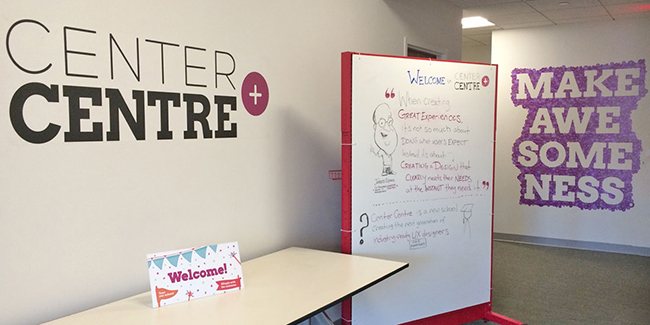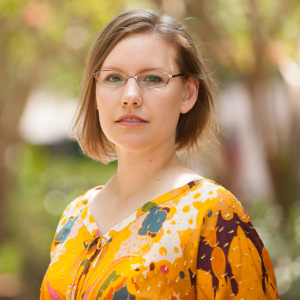- Published on
Howdy. I’m Leslie Jensen-Inman, a designer, speaker, author, and educator. As Co-founder and Institutional Director of Center Centre—the user experience design school—I connect industry, education, and community. I combine nearly 20 years of design practice and eight years of instructional background—including five years as an assistant professor at the university level—to make Center Centre an extraordinary learning environment.
I believe that transformative, meaningful learning occurs when students engage in real projects with real constraints and real stakeholders. Through project-based learning, Center Centre’s program prepares students to be industry-ready, junior UX designers.
I share my research and thoughts on design, learning, leadership, and community through writing and speaking. I creative directed and co-authored the book, InterACT with Web Standards: A Holistic Approach to Web Design. I write articles for publications such as A List Apart, The Pastry Box, Ladies in Tech, and .net Magazine. And I speak at events such as Build, Converge, SXSWi, Madison+, Blend, UXCamp DC, In Control, Fronteers, A Web Afternoon, and Web Directions South.
How did you get started in design / UX design? What is your background?
When I was about five years old, I was learning how to write my ABCs. I mean really write them. On proper thick ruled paper. I was focused on getting my letterforms just right. To achieve this goal, I would write and erase the letters over and over again. So much so that I would wear through the paper and have to start all over again.
My mother didn’t scold me for erasing through the paper. She didn’t say, "Leslie, you have to stop ... this is crazy.” Instead, she bought me more paper. She recently told me, "I didn’t know it then, but you were kerning—you were letter-spacing.” (I have a pretty awesome mom.)
Another thing happened when I was five years old. I discovered that I have scoliosis—basically my back curves in very interesting ways. By the time I started high school, I was wearing a back brace, 23 hours a day, trying to straighten my curves. I was not allowed to take gym class, and this also meant no more physical extracurricular activities like basketball or cheerleading.
Being a bit broken physically forced me to focus on other skills. All of a sudden, I had a lot of extra time. I had a lot of time to design.
For my entire four years of high school, I took independent courses in graphic design. My extracurricular activities switched from cheerleading to being on the yearbook staff, being an active member of the AV Club, and working freelance design jobs (mostly laying out newsletters using PageMaker).
In undergrad, I double-majored in graphic design and video/film at Savannah College of Art and Design (SCAD). I knew I needed a Masters in Fine Art (MFA) to be able to teach at the university level, so I earned mine in Integrated Design at the University of Baltimore. While an assistant professor at the University of Tennessee at Chattanooga (UTC), I earned a doctorate in Learning and Leadership. During all of my higher education, I maintained a professional design practice.
All of this has given me a broad understanding of how education has been done and what it’s like to design in the real world—and that we need a new approach to better prepare junior designers. That’s why we started Center Centre.
Let’s talk about the creative process and how you work.
My creative process is an iterative learning process.
Like most people, I go through the four stages of learning:
- Unconscious incompetence
- Conscious incompetence
- Conscious competence
- Unconscious competence
To move through the four stages of learning, I use an iterative process that includes the following steps: Plan ? Implement ? Measure ? Learn ?.
This iterative process provides a fixed framework that allows for a ton of flexibility.
- Plan
- Ask big questions. o Conduct lots of research.
- Write a lot, including a lot of freewriting [](http://books.google.com/books?id=lFqnviLu4fsC&lpg=PP1&dq=peter elbow&pg=PA13%23v=onepage&q&f=false)and [open-ended writing](http://books.google.com/books?id=lFqnviLu4fsC&lpg=PA51&vq=open-ended writing process&pg=PA58%23v=onepage&q&f=false). o Sketch and prototype.
- Write down the plan (including how to implement it and what I need to measure to know that I’ve achieved my goals).
- Implement
- Do whatever it takes (and that’s appropriate) to get the plan in action and get it finished.
- Measure
- Measure to see if I achieved my goals.
- Learn
- Ask and answer: What is the most important thing I learned and how will what I learned change the way I approach things in the future?
- Ask and answer: If I do this again, what will I continue to do, start doing, and stop doing?
- Ask and answer: Is another iteration of this process necessary for this project?
What tools and software do you use for your work?
Software
- Slack
- Day One
- Google Apps (mostly Google Drive and Google Calendar)
- SendLater
- Unroll.me
- Basecamp
- 1 Password
- TextExpander
- Zapier
- IFTTT
- Dropbox
- Alfred 2
- Adobe Creative Suite
- Keynote
- Evernote
- Overcast
- PaperKarma
- Safari
- Chrome
- Goodreads
- Pages
- Word
- Numbers
- Excel
- TextWrangler
- Grammarly
- Skype
- FaceTime
- Kindle
- TweetDeck
- Sprout Social
- F.lux
- Fluid
- Clean
- Trello
- Highrise
- LinkedIn (feel free to connect with me there!)
- TripIt
- Ecquire
- Reading.am
- Readability
- Fancy Hands
- Manager Tools and Career Tools
- All You Can Learn
Hardware
- Sticky notes
- Index cards
- Sharpies, pens, mechanical pencils
- Notebooks
- Rolling whiteboards, whiteboard markers
- MacBook Pro Retina (hooked up to Thunderbolt Cinema Display when at Center Centre)
- iPhone 6
What are you working on now?
Long-time user experience (UX) expert, Jared M. Spool, and I have founded Center Centre; the user-experience design school creating the next generation of industry-ready UX designers.
Center Centre’s one-of-a-kind, built-from-scratch curriculum prepares well-rounded junior user experience designers that companies need. Located in downtown Chattanooga, TN, we’re a bricks-and-mortar school offering a two-year, full-time program in user experience design—the first and only of its kind. (We’re currently accepting student applications!)
A cool thing about creating a new type of school, with new content, and a new structure is that everything we create is, well, new. It hasn’t been done before. There is no best practice.
We’re making the best practices as we’re making the school.
If you dropped by the school, you might find me participating in a tech-free meeting, crunching numbers in a spreadsheet, writing content, or developing a communications strategy. Or you might show up at the school, and I wouldn’t be there. Instead, I’d be giving a presentation to high school girls, meeting with a potential partner company, or raising money for our Centre Make Awesomeness Scholarship Fund. (By the way, we’re on the hunt for more partners in both of those capacities.) Some days, I do a little bit of most of these things. One day is never quite the same as the next. I am never bored, and I’m always learning.




What is your ideal work environment?
Ideally, I’m working someplace where it is really quiet or where there is a constant hum of noise that turns into white noise. Because what I’m working on varies so much, I need to be able to focus. I like as few distractions as possible, especially when I’m writing.
My ideal work environment includes working with thoughtful and driven people. At Center Centre, we have an amazing team of folks. Every team member brings his or her unique skill set to solve really big challenges. It’s a lot of fun to work with people who understand the value of what we’re creating—people who see the importance of developing a new kind of learning environment.
Where are your favorite places for sharing experiences?
In Chattanooga. At Center Centre. On a rolling whiteboard or on a wall with lots and lots of sticky notes.
Part of what makes my job so exciting is the sheer number of shared experiences and partners I get to collaborate with. Our goal is to get our students teamed up with partner companies on real-world projects that provide both a useful end product for the company and transformative learning experiences for our students.
We are always looking for more partners to share in our new education adventure. We’d welcome large companies with projects to partner on. Get in touch, if your company is interested in partnering with Center Centre.
Who are the designers you admire most?
I admire a lot of different designers who design in a lot of different mediums. Some of the folks I admire the most are Shaun Inman, Wren Lanier, Veerle Pieters, and Jenn Lukas.
Shaun Inman is an incredible game designer/developer. Yes, he’s my husband. And no, he didn’t ask me to write this. I’ve had the opportunity to witness Shaun’s design skills and talents develop over the last 15+ years. It’s an incredible opportunity to witness and be a part of someone’s journey through design for such an extended period of time.
Wren Lanier is a UX designer. I enjoy her outcomes-based design process. She’s smart and thoughtful, and these traits show in her work. Wren does some crazy awesome Z-axis stuff. She explains it best.
Veerle Pieters is a graphic/web designer. She’s kind and gives so much to the design community. I’m often completely blown away by her in-depth tutorials that often focus on Illustrator and Photoshop.
Although not exactly a designer, front-end developer, Jenn Lukas, is pretty spectacular. I enjoy the way she shares information. She helps move our industry forward through speaking, teaching, and writing.
I admire our entire Center Centre team for designing a new educational experience. There’s nothing easy about crafting a nontraditional school from scratch. Every day the members of the Center Centre team work diligently to meet the needs of learners and industry.
